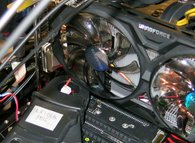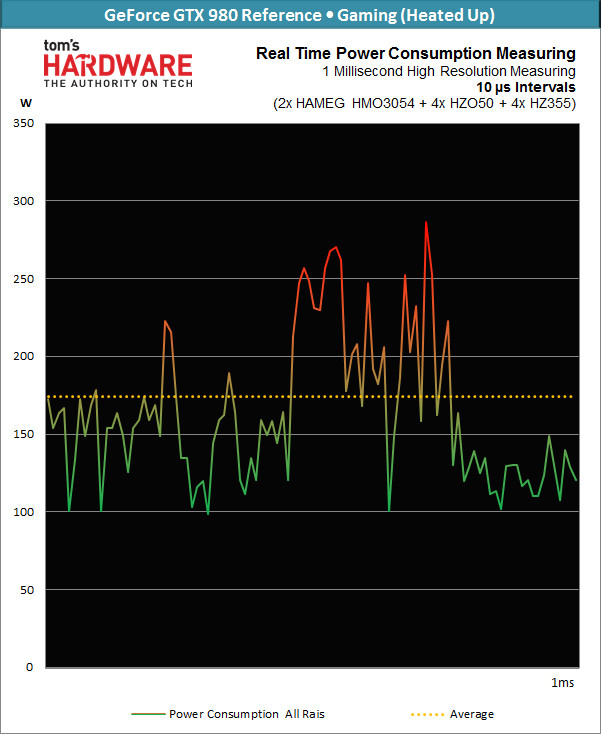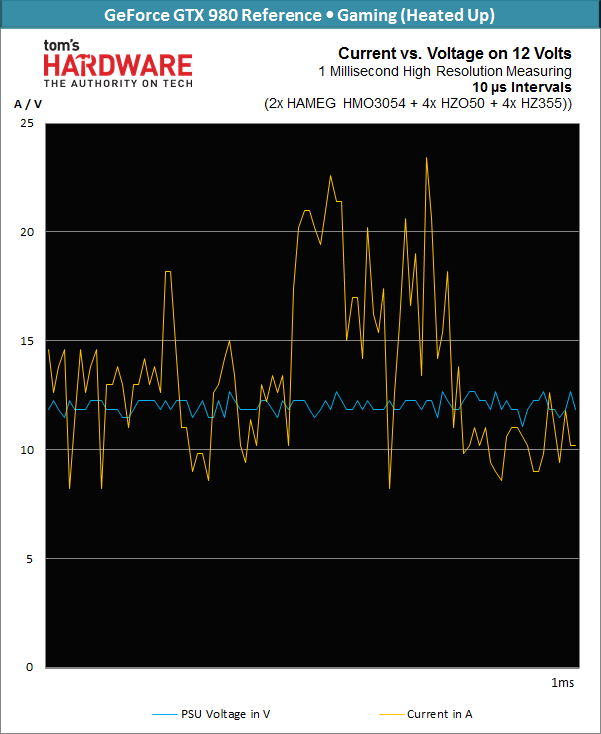Nvidia GeForce GTX 970 And 980 Review: Maximum Maxwell
A New Power Consumption Test Setup
Nvidia's newest architecture presents us with a whole new set of challenges for measuring power consumption. If the maximum of all four possible rails are to be measured exactly (to find out Maxwell’s power consumption reduction secrets), then a total of eight analog oscilloscope channels are needed. This is because voltage and current need to be recorded concurrently at each rail in real-time. If the voltages are measured and then used later, the result may be inaccurate. So, how did we solve this problem?
We enlisted the help of HAMEG (Rohde & Schwarz) to search for a solution with us. In the end, we had to use two oscilloscopes in parallel (a master-slave triggered setup), allowing us to accurately measure and record a total of eight voltages or currents at the same time with a temporal resolution down to the microsecond.
The measurement intervals need to be adjusted depending on the application in question, of course, in order to avoid drowning in massive amounts of data. For instance, when we generate the one-minute graphs for graphics card power consumption with a temporal resolution of 1 ms, we have the oscilloscope average the microsecond measurements for us first.
We use a riser card on the PCIe slot (PEG) to measure power consumption directly on the motherboard for the 3.3 and 12 V rails. The riser card was built specifically for this purpose.



In addition, we separately measure the voltage and current at each of the two individual PCIe power connectors.
| Test Methodology | No-contact current measurement at all railsDirect voltage measurementIR real-time monitoring |
|---|---|
| Test Equipment | 2 x HAMEG HMO3054, 500 MHz Four-Channel Oscilloscope with Data Logger4 x HAMEG HZO50 Current Probe 4 x HAMEG HZ355 (10:1 Probe, 500 MHz) 1 x HAMEG HMC8012 DSO with Data Logger1 x Optris PI450 80 Hz Infrared Camera + PI Connect |
| Test System | Intel Core i7-5960X, 4.2 GHz16 GB G.Skill Ripjaws DDR4-2666 (4 x 4 GB)MSI X99 Gaming 72 x Transcend SSD370 (System, Applications + Data, Storage)be quiet! Dark Power Pro 1200 WMicrocool Banchetto 101 |
Nvidia’s GPU Boost Accelerates Maxwell
Everything makes sense in theory, but we still want to know how Maxwell achieves better efficiency at this magnitude. Kepler already adjusted the GPU’s voltage quickly and exactly depending on its load and temperature, and AMD’s PowerTune did the same thing as well. It turns out that Maxwell refines the formula further. With its shaders fully utilized, the new architecture's advantage over Kepler practically vanishes. So, Maxwell depends on its superior ability to adjust to changing loads, and, consequently, it’s able to tailor the power consumption even better to the needs of the application in question. The more variance there is, the better Maxwell fares.
To illustrate, let’s take a look at how Maxwell behaves in the space of just 1 ms. Its power consumption jumps up and down repeatedly within this time frame, hitting a minimum of 100 W and a maximum of 290 W. Even though the average power consumption is only 176 W, the GPU draws almost 300 W when it's necessary. Above that, the GPU slows down.
Get Tom's Hardware's best news and in-depth reviews, straight to your inbox.
Now, how do the PSU’s important 12 V rail's current and voltage behave under these conditions? We add them up for this purpose.
The PSU doesn’t supply a constant 12 V supply voltage. Spikes that empty the secondary capacitors and the slower power supply that tries to fill them back up again cause voltage fluctuations that the graphics card's five phases must take care of. All of these interactions make our measurements more complicated than a log of averages would suggest.
Current page: A New Power Consumption Test Setup
Prev Page Results: Assassin's Creed IV, Watchdogs, Far Cry 3 Next Page Power Consumption In DetailDon Woligroski was a former senior hardware editor for Tom's Hardware. He has covered a wide range of PC hardware topics, including CPUs, GPUs, system building, and emerging technologies.
-
lancear15 I was waiting for Tom's review to make my final decision, the 980 is definitely going into my current 5960x build! I cant wait.Reply -
HKILLER so how long before you do a round up?i mean this time i've seen some pretty crazy looking cards (Zotac's Extreme AMP! edition looks crazy and the Inno3D too)and EVGA has shown off ACX 2.0 which they claim to be the most efficient GPU air cooler in the world...so many to choose from also EVGA FTW has been nicely overclocked i've seen it performing almost on par with 980Reply -
realibrad byt he way... Last page 2nd sentence after the graph of Avg game performance.Reply
I was hoping for more performance but the efficiency is quite nice. They just put pressure on the top end and gave us a price reduction, instead of overall performance gains. -
balister Very nice, but I still want to see what the power consumption along with what might be possible with the drop to 20nm (since this is still 28nm).Reply
Likely, we're going to see a Maxwell Titan equivalent come in the next year or so as these are a x04 much like Kepler with the 670/80s were and we're still going to be waiting to see what the x10 will be with the Maxwell architecture. -
MANOFKRYPTONAK Why didn't you include an overclocking comparison? Why didn't you include the 780, but included the 770? Doesn't make much sense...Reply -
vertexx 970 is the real story until the 980ti comes out - what a value proposition with the 970!Reply
Good stuff here - but you guys were a bit slow on this one. Tom's Hardware is the first site I visit every morning. But with the delay of this article, I've been all over the net this morning on other sites that got their stuff out sooner. -
daveys93 Will there be a follow-up article about overclocking these cards? Other sites are showing results that both of the new cards are capable of 1500+ MHz on air (aftermarket coolers and even a few with stock coolers), which is a massive overclock. Looks like NVIDIA left the door open for some decent voltage increases, but many results have been in the 1450-1500 MHz range at stock voltage. I am a big fan of the thoroughness of Tom's articles so I am very interested in seeing overclocking results and analysis from this site.Reply



